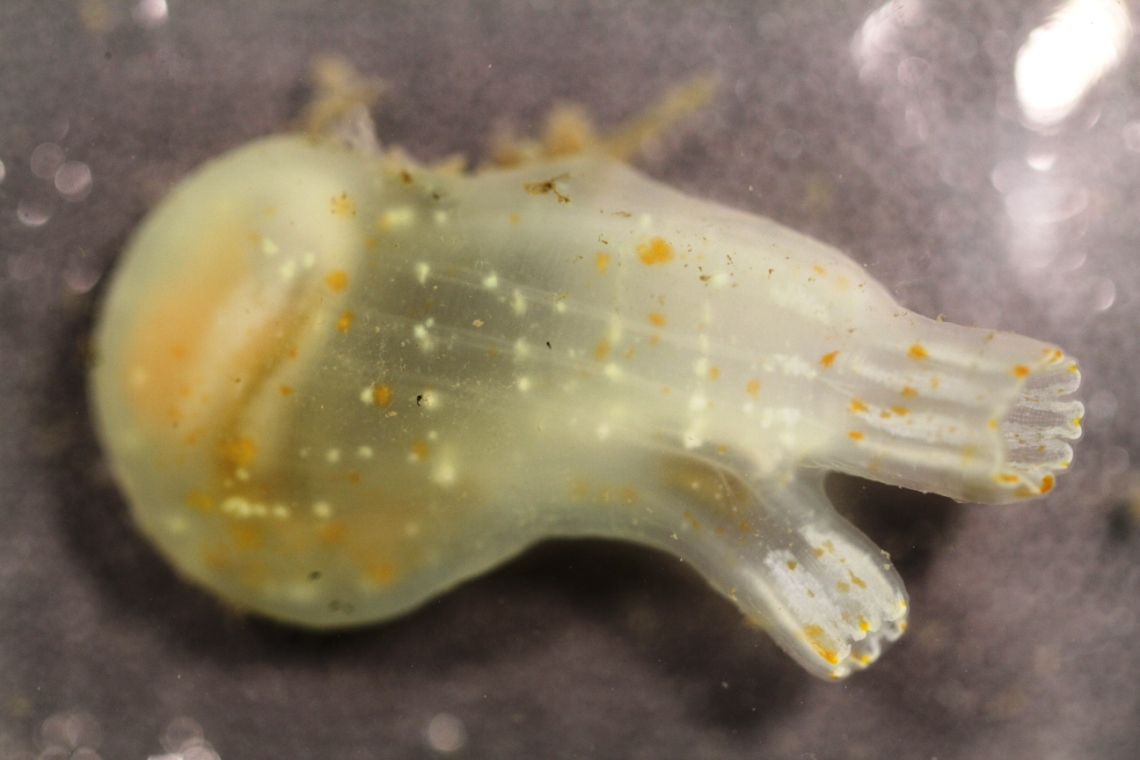Target Taxa
Tunicates
Botrylloides violaceous
Image courtesy of Melissa Frey, Royal BC Museum, Canada.
Botrylloides violaceus is native to the Northwest Pacific from northern Japan to southern Korea and northern China. It has been widely introduced to the Northeast Pacific, the Northwest Atlantic, and parts of the Northeast Atlantic. On the West Coast of North America, it was first discovered in Santa Barbara, California in 1966 and has since spread along the coast from Mexico to Alaska. On the East Coast, it was found in New England in the late 1970s and can now be found from the Chesapeake Bay to Newfoundland, Canada. It is a common fouling organism throughout much of its introduced range. It frequently displaces other fouling organisms, including native and introduced tunicates, bryozoans, barnacles, and mussels through competition for space and food.
More informationBotryllus schlosseri
Image courtesy of Melissa Frey, Royal BC Museum, Canada.
The origin of the Golden Star Tunicate, Botryllus schlosseri, is uncertain. It is globally widespread and found on temperate coasts in Europe, Asia, both sides of North America, Chile, Argentina, South Africa, Australia and oceanic islands such as Bermuda, the Azores and New Zealand. It is common in fouling communities and has likely spread globally through shipping, oyster culture and other aquaculture transfers. In the lower Chesapeake Bay, B. schlosseri is a fouling pest impacting oyster aquaculture, but not natural oyster beds. In some areas of its introduced range, there is concern that B. schlosseri competes with native species for space, especially on artificial substrates where it can grow rapidly.
More informationCiona robusta

Image courtesy of Melissa Frey, Royal BC Museum, Canada.
The Sea Vase tunicate, Ciona robusta, is globally distributed and can be found on every continent except Antarctica. Because of this broad range, its native range is difficult to determine. It appears to be native to the North Atlantic, but is introduced to the South Atlantic, Pacific, and Indian Oceans. It commonly fouls ships and docks and was likely transported around the globe by shipping. It was discovered as early as 1838 in Boston Harbor, Massachusetts, but whether native to America, Europe, or both coasts, is not yet known. Ciona robusta was first reported on the West Coast of North America in 1897 in San Diego Bay, California. Its established range currently extends from Ensenada, Mexico to Bodega Harbor, California, but it has been reported from as far north as British Columbia, Canada. Ciona robusta has negative economic impacts on shellfish aquaculture in Nova Scotia, Canada and South Africa where it is said to reduce the growth rates of cultured mussels and foul ropes and equipment. It is also a formidable competitor, quickly occupying space and potentially displacing native fouling species.
More informationCiona savignyi

Image courtesy of Melissa Frey, Royal BC Museum, Canada.
Ciona savignyi appears to be native to Japan and possibly offshore waters of Alaska and British Columbia. Introduced populations were first reported on the West Coast of North America in 1985 at Long Beach Harbor, southern California. Since then it has been reported in a number of southern, central and northern California locations, including San Diego Bay, Santa Barbara Harbor, Monterey, Moss Landing, San Francisco Bay, Tamales Bay, Bodega Harbor, and Humboldt Bay. In 1998 it was found in Puget Sound near Seattle, Washington, and there are reports of extensive populations in several areas of Puget Sound and the northern reaches of the San Juan Islands. It is abundant in harbors and marinas and was likely spread through hull fouling on commericial and recreational boats. Despite its abundance in the fouling community, very little is known about its impacts, but it might compete with C. robusta, however, die-offs of both species due to environmental changes make this difficult to assess.
More informationDidemnum vexillum
Image courtesy of Melissa Frey, Royal BC Museum, Canada.
Didemnum vexillum is a rapidly spreading colonial tunicate that overgrows rocks, shellfish, and other organisms (e.g. sponges, hydroids, tunicates, algae). It probably originated from the Northwest Pacific, possibly Japan, but has been reported in several parts of the world including New Zealand, North America, and Europe. Its identification in these introduced areas had been debated, but recent genetic and morphological studies confirmed that many of these global populations are D. vexillum. Its first known occurrence on the East Coast of the US was in Damariscotta River estuary, Maine in 1982. It is now common from Shinnecock Inlet, New York to Eastport, Maine. The first occurrence of D. vexillum on the West Coast was in San Francisco Bay in 1993, but it can now be found from Bahia San Quintin, Mexico to Sitka, Alaska. Didemnum vexillum has the potential to cause significant economic damage to fisheries and aquaculture. It can also have negative ecological impacts and in some areas its rapid expansion has reduced the abundance of previously established benthic species.
More informationStyela clava

Image courtesy of Anya Dunham, Department of Fisheries and Oceans, Canada.
Styela clava, is commonly known as the leathery or club tunicate. It is solitary and has a thin, but leathery and bumpy tunic. Its body is cylindrical or club-shaped and is attached to the substrate with a stalk. It is native to the Northwest Pacific, from Shanghai to the Sea of Okhotsk and the Southeastern Bering Sea. It has become widely distributed in coastal waters, through ship fouling and transport with oysters. It has been introduced to both coasts of North America and to Europe, Australia and New Zealand. In some areas of its introduced range, S. clava adversely affects aquaculture production by fouling cultured species and equipment. It can also grow in dense clumps, dominating large patches, and outcompeting other fouling species.
More information